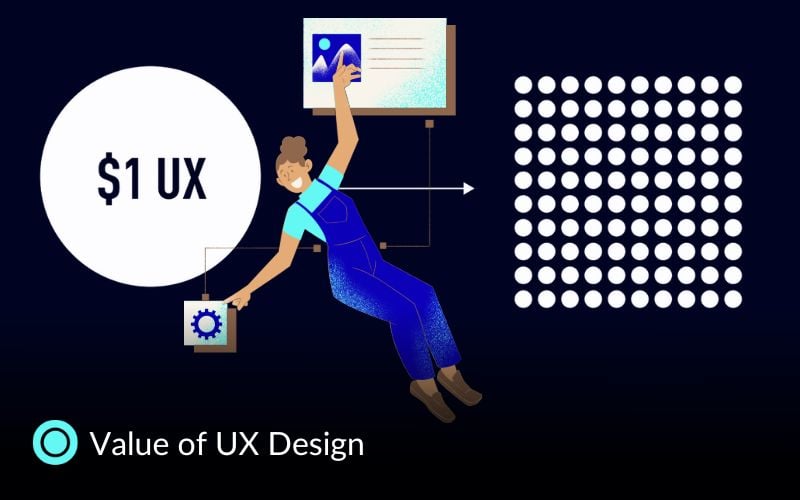Key Takeaways:
-
The value of UX is reflected in improved customer satisfaction, increased loyalty, and higher revenues through better user engagement.
-
The value of UX design can be measured using metrics like conversion rates, task efficiency and customer retention, proving its direct impact on business success.
-
Certified UX professionals enhance the value of user experience by applying standardized techniques, driving innovation and aligning design with measurable business outcomes.
What is the value of UX design?
It's no secret that great UX design leads to excellent business outcomes. Numerous research pieces draw direct connections between UX and positive business outcomes. For instance, organizations investing in UX design realize increased ROI through the reduction of product support costs by minimizing losses due to poor usability. Moreover, 75% of users judge the credibility of a firm by its website's layout and design first impressions do count, a factor very much considered in Stanford Credibility Study.
Companies said, in the 2022 State of User Research report, that prioritizing UX results in better customer satisfaction and retention, while happier users create louder brand advocates and greater brand loyalty. On the opposite end of the spectrum, poor user experiences contribute to what has been called "The Trillion Dollar UX Problem," showcasing the direct cost of neglecting improvement of UX in digital products.
The evidence in support is clear: investment in UX design pays off and creates a competitive advantage. It leads to increased revenues and better customer engagement, thus resulting in the sustainable growth of companies.
How to Measure ROI of UX Design?
Measuring the return on investment of UX design involves different methods that estimate its influence on major business metrics. Such techniques help organizations link UX improvements to measurable outcomes; in most cases this might be specific to certain industries or applications for relevance.
1. Better Conversion Rates
One of the simplest ways to quantify UX ROI is to determine how efficiently users are completing key goals, like purchases or sign-ups for services. An intuitive design removes barriers and can seriously hike those numbers, often turning into increased revenue.
Where it's applied:
Conversion rate metrics are even more crucial in e-commerce, subscription platforms and marketing websites because user actions translate into direct business value there.
2. Cost Savings by Means of Efficiency
UX improvements often have the added benefit of freeing up the user's time and other resources when trying to achieve their goals. Measuring task completion times during usability tests provides valuable insights.Faster processes translate into both customer satisfaction and lower operational costs.
Where it's applied:
This technique is in wide use within enterprise software, customer service tools, and internal business systems where streamlined workflows equal efficiency.
3. Low Demand for Customer Support
The more sophisticated and ambiguous the interface is, the more customer inquiries it will generate. Meanwhile, every improved design minimizes support requests, thus saving money and decreasing work for support teams.
Where it's applied:
Sectors like banking, healthcare and fin-tech will be using it because they have complex products on offer, wherein streamlined UX reduces confusion and support burdens.
4. Increased loyalty of customers
A design that is user-friendly can improve customer satisfaction, hence improving retention. Loyal customers are bound to return for more and recommend the business to others, translating into increased overall revenues.
Where it's applied:
This is especially valuable in subscription-based services, such as streaming platforms, industries in the field of hospitality and retail where repeat customers are core to long-term growth.
5. Metrics of Satisfaction and Advocacy
The most common way of measuring the impact of UX on customer sentiment is using metrics such as NPS or user satisfaction ratings. Those will, in turn, make them advocates for your brand, fostering growth by word of mouth.
Where it's applied:
These are also very common metrics for any startup, SaaS platforms and consumer tech products to determine the level of satisfaction of users and the likelihood of recommending the product.
6. Integrating UX with Business Goals
Organizations often compare metrics before and after UX improvements; these may include lifetime customer value or the effectiveness of marketing campaigns. This analysis makes it easier to demonstrate the long-term value of UX investments.
Where it's applied:
It serves particularly useful in industries such as insurance, education, and B2B services, where the customer relationship is long-term and improvements created pay measurable dividends over time.
7. A/B Testing for Data-Driven Decisions
A/B testing allows companies to pit multiple design variations against each other to find the best result. This is how optimization happens iteratively.
Where it's applied:
This technique is widely being applied in digital marketing, e-commerce, and mobile development since user behavior can be judged real-time.
These techniques applied across industries enable businesses to measure and demonstrate the value of UX design in their bottom line. Each technique is tailored to the context in which UX investments are made and where maximum value can be attained.
Examples of Companies Leveraging Value from UX Design
1. Migros: How to Increase Mobile Application Engagements with Automatised Campaigns
Migros, the largest retailer in Switzerland, wanted to increase the user activity of its app "Einkaufen und Sparen". Thanks to automated app campaigns, they achieved 32% more installs in comparison with the same period of time the previous year. Moreover, in-app actions, such as linking the Cumulus account, increased by 29% in June 2020 after running the campaign. This strategy expanded their user base and heightened the intensity of customer interaction with the app, really demonstrating how targeted UX enhancements can make a difference in terms of user engagement.
2. PwC: Prioritizing Customer Experience to Drive Business Success
According to PwC's "Future of Customer Experience" report, 73% of consumers mark customer experience as the justifying reason for making purchases.
Despite this, only 10% of companies said creating better customer experiences was a digital priority in 2017, down from 25% in 2016. This disconnect suggests that businesses focusing on enhancing UX can gain a competitive advantage, as consumers are willing to pay more for a superior experience.PwC's findings underscore the critical role of UX design in meeting consumer expectations and driving business growth. PWC Examples will be given to show how strategic investments in UX design result in increased user engagement and business success.
How Certified UX Professionals Quantify the Value of Design
Certified UX professionals, particularly those with UXQB certification, ensure that design improvements are user-centered and business-effective. Their structured approach, grounded in internationally recognized standards, not only enhances user satisfaction but also drives measurable business results. By integrating principles of usability, design thinking, and innovative problem-solving, they contribute to the overall value of user experience. This value is reflected in increased customer loyalty, better engagement, reduced costs and competitive advantages, making UX investments a strategic priority for businesses.
1. Standardized Methodologies
UXQB certification means that professionals are trained with substantial theoretical grounding regarding user-centered design, usability testing, and research. Consequently, this standardized knowledge will enable them to apply consistent methodologies across projects for reliable and comparable results.
- CPUX-F starts with the topic 'Plan a human-centred design project', and even covers interculturalisation methods like the IUID process in CPUX-DS.
2. Implementing UX Principles
The certified professionals are trained in applying UX principles effectively in real-world scenarios. They vary their techniques from wireframing and prototyping to usability testing in driving the design toward meeting both user and business needs.
- CPUX-F introduces this with 'Design solutions that meet user requirements,' while CPUX-DS expands from 'Early design' to 'Aspects' beyond the design activities.
3. Enhanced Problem-Solving Skills
The certified UX professionals can identify usability issues in the early design process using structured methodologies. The whole process is proactive, meaning it saves time and resources before problems get huge.
- CPUX-F addresses this with 'Evaluate the designs against user requirements,' while CPUX-UT goes into much more detail on usability testing and user surveys.
4. Enhanced Communication and Cooperation
UXQB certification standardizes the terms used in UX for better communication among team members and stakeholders, hence one language can lead to clearly defined design objectives and their delivery.
- CPUX-UT covers 'Communicate usability findings', whereas CPUX-DS includes 'Documenting design decisions', and CPUX-M focuses entirely on this, with topics such as 'Creating a shared HCD culture'.
5. Integrating Design Thinking
Many certified professionals incorporate design thinking methodologies into their processes.This ensures innovation, making the solution creative and user-centered.
- CPUX-F starts with ‘Human-centred design,’ and CPUX-M extends the scope to topics like ‘Boosting HCD maturity’ and ‘Measuring the business value of HCD activities.’
Featured Resource:
UXQB and Design Thinking: A Perfect Pair for Usability
6. Contribute to Digital Transformation
In the context of digital transformation, UXQB-certified professionals ensure that new technologies and systems are user-friendly, promoting seamless adoption and integration. By applying these competencies, the certified UX professional effectively quantifies and enhances the value of design toward improved user satisfaction and business success.
Contributions range from User Requirement Engineers to Design Solution Managers; it nurtures collaboration and therefore maximizes their impact in the processes of digital transformation.
Conclusion
UX pays off in terms of better user satisfaction, more loyalty, and business outcomes that one can measure. Companies invest in UX to make customers happy, but also to generate impressive ROI, competitive advantages and long-term growth. More specifically, certified UX professionals-UXQB certification-will play a key role in implementing standardized methodologies along with innovative strategies that clearly align design improvements with business objectives. Prioritizing the value of the user experience is no longer an option but a strategic necessity to be able to realize sustainable success within the digital competitive landscape today.





